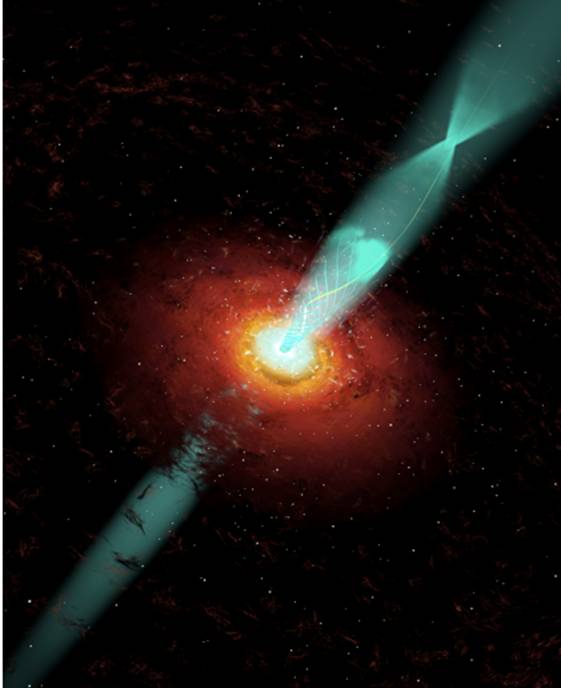Nature has provided us with spectacular particle accelerators called active galactic nuclei, or AGN. These are galaxies that host tremendously large black holes at their centers, some of which are known to be a million times heavier than our sun. hese distant celestial laboratories allow researchers to study physics at energies orders of magnitude greater than what can be generated by the most powerful manmade accelerators on Earth.
Many - if not all - galaxies contain massive black holes in their center: there is even a prominent one in the heart of our own Milky way galaxy. The gravity in the vicinity of a black hole is so intense that even light cannot escape. Those black holes grow by swallowing, or "accreting" Galactic gas from their vicinity, and can reach a mass equivalent to millions or even a billion times more than our Sun. But before such gas falls into the black hole, it heats up, and can generate a vast amount of electromagnetic radiation: those are known as active galactic nuclei. In some cases, some modest fraction of the material falling onto the black hole is sent off away from the black hole, along the axis of its rotation, in a form of great outflows, or “jets," moving with speed close to the speed of light. Such jets produce additional radiation, usually seen as intense radio waves, X-rays, and gamma-rays. The most luminous of such active nuclei might vastly exceed all light produced by all ordinary stars in the entire galaxy - even though that light is generated in a region with a size comparable to our Solar system.
Active galactic nuclei are responsible for other powerful phenomena such as quasars and radio galaxies. When the galaxy is oriented so that the jets of energy exiting the black hole are pointed toward Earth, the observations become even more dramatic. These objects are called blazars.
In a blazar, the emitted light may include high-energy gamma rays, which, in extreme cases, can be a billion times more energetic than the light our eyes can see. The light generated by a blazar has other unique properties, including an intensity that can vary dramatically with time. At peak emission, observing a blazar feels a little like looking down the barrel of the most powerful gun in the universe. (In some cases, the material exiting a blazar appears to be moving faster than the speed of light, but this is an illusion caused by the geometry of a high-speed source that is not oriented exactly head-on with the observer.)
KIPAC scientists are heavily engaged in the search for and study of blazars. The Fermi-Large Angle Telescope, or Fermi-LAT, is one of the most efficient instruments ever designed to probe the universe for blazars. It is providing the Stanford community with streams of new data in the effort to understand the physics of these rare and fascinating cosmological objects.
Click the images below to see a larger version

Hubble Space Telescope image of the active galaxy M87. The defining feature of an AGN is huge jets of particles and radiation that shoot from the center in opposite directions. One of the jets from this AGN is clearly visible in the bluer light, which contrasts with the yellow light of the host galaxy.








